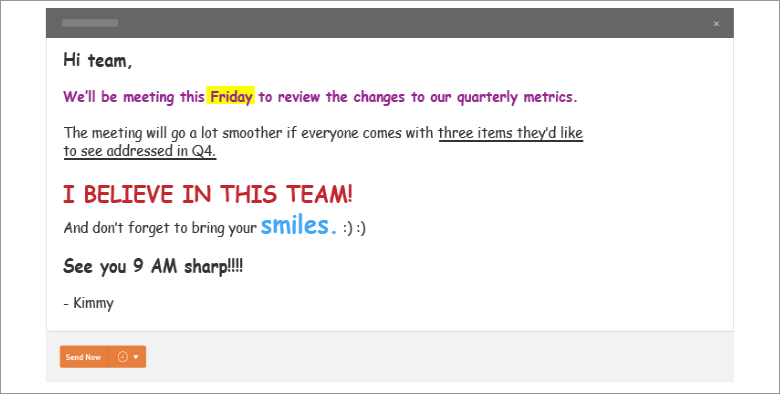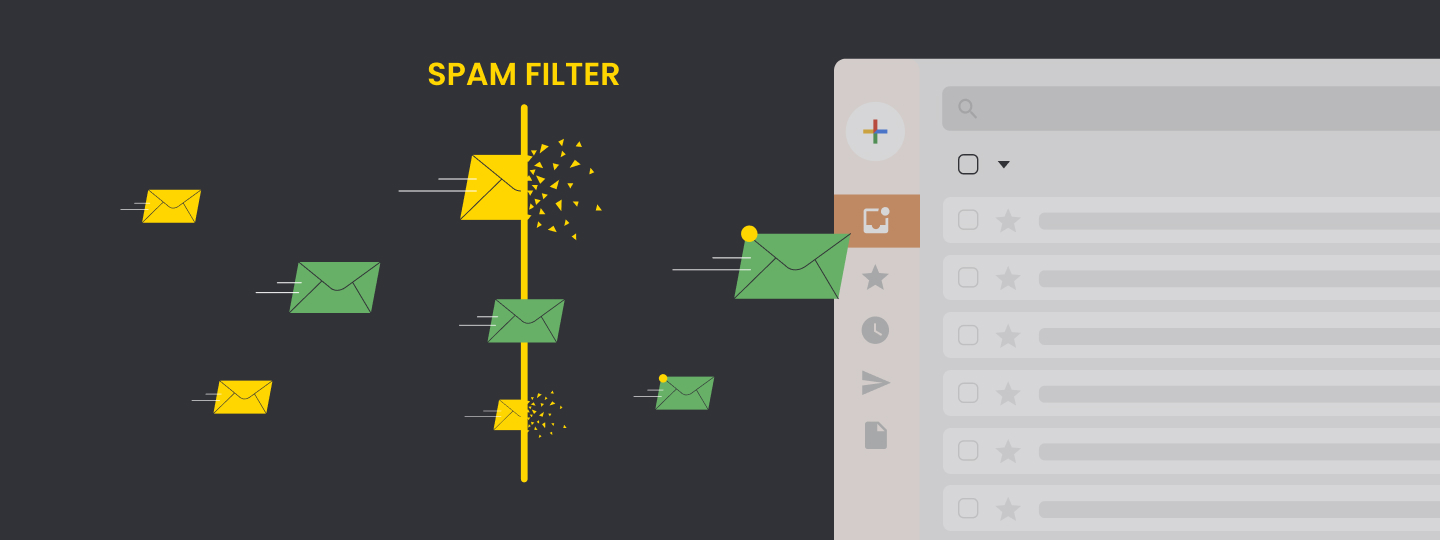If you are in the email marketing business, you are under the constant pressure of having to think about spam traps, trigger words, and anti-spam laws. Crafting targeted emails so as to avoid common spam filter triggers or being marked as spam by your subscribers has become an art in itself.
Why? Because Internet Service Providers (ISPs) are waging a brutal yet justified war against spammers. Unfortunately, the victims are not always just the spammers. Collateral damage happens to include some of us, the good-willed email marketers who simply don’t have the luck or enough experience.
Research indicates that one in every six genuine, consent-based emails don’t make it to the recipient’s inbox. How come? Well, only a small error is enough to send an email from an honest email marketer to the 9th circle of email marketing hell, causing severe, almost irreparable damage to email deliverability and the sender’s reputation.
The seriousness of the issue is evident from the very fact that almost every internet front country has lawfully restricted the use of email spam. The American CAN-SPAM Act of 2004 and Canadian CASL of 2014 (Canada’s Anti-Spam Legislation) represent the leading states’ attempts to protect people from unsolicited and unrequested bulk mail. Along with the ISPs, they seem to be doing a good job.
So, I would like to present the dos and don’ts of targeted email marketing. This comprehensive guide will help you navigate around spam traps and filters to arrive at the desired inbox securely, and you will learn how to avoid spamming in email marketing. Mastering these email marketing best practices to avoid spam can make a significant difference in your campaigns.
What are Spam Traps and How to Avoid Spam Filters When Sending Emails?
ISP’s first line of defense against spammers is spam traps. They are actually email addresses explicitly designed for identifying and tracking spammers.
If your triggered email hits such an address, you are immediately flagged as a spammer by the ISP. Your IP address and your ‘from domain’ get blocked, your deliverability rates plummet, and it can take you up to a year to restore a good sender reputation. This is how pure spam traps function. Pretty scary!
Another thing to worry about is recycled spam traps. They are inactive email addresses that ISPs acquire after a certain period of inactivity. If your email hits such an address, the consequences are not as serious. Either your ESP or the ESP of your client will send you a notification of the bounce to let you know you are emailing a dormant address. But, if you continue to send emails to hard bounces, the ISP will eventually record it as a spam trap hit.
ISP’s second line of defense against spammers is spam filters, a program that, by using different criteria, filters out unwanted and unsolicited bulk mail, thus preventing it from ever reaching email inboxes. Understanding how to avoid spam filters is crucial, as they scrutinize your targeted emails to the minutest details to make sure irrelevant and poorly written content never reaches the subscribers.
Without further ado, here are the things to take care of to avoid spam filters:
- Pay Attention to Technicalities
- Use a recognizable sender name
- Choose a reliable ESP – Email Service Providers
- Get a certificate from a third-party
- Check if you are a blacklisted sender
- Test your emails before sending them
- Always be up-to-date with spam filter technology, ISP practices, and anti-spam law
- Keep email lists clean
- Email only those who gave you permission
- Never, ever buy email lists!
- Remove hard bounces from your mailing lists
- Pay attention to the dormant subscribers
- Ask for the subscription twice
- Respect the unsubscribers
- Take good care of the subject lines
- DON’T SHOUT AT PEOPLE
- Stay away from spam trigger words
- Don’t make false promises
- Take good care of the email body
- Avoid rich media content
- Avoid embedding forms
- Avoid including attachments
- Tone down the fonts and colors
- Cut back on the images
- Make sure your images display correctly
- Offer both plain text and HTML
- Correct spelling and grammar
- Make it easy to unsubscribe
- Take care of the follow-up
1. Pay Attention to Technicalities
There are certain technical issues surrounding the process of triggered email marketing that you can take care of to maximize your email deliverability:
2. Use a recognizable sender name

It’s a good practice to use personalization and always strive to send emails from an email address that contains preferably your personal name with your brand name so that the recipients recognize you avoid spam filters..
Why? Simply because in the sea of emails they receive every day, they have to choose which ones to open. And people prefer to open those which include a personal name in the ‘from’ box, rather than impersonal, generic one.
A study by Finances Online shows that 45% of email recipients will click spam based solely on the info they see in the ‘from’ field, name and email address.
Email addresses such as firstnamelastname@domain or any variation are always a good choice.
Moreover, leading Email Service Providers (ESPs) tend to pay close attention to the ‘from’ field. Why? Spam technology also has reputation-based filtering that gathers information about the source of the message (IP address and domain) among other things. Changing the source IP address often signals shady business to ESPs. They will alert the ESP to perform a check on you. And if you inadvertently choose a blacklisted address, your email will be filtered out. Ultimately, changing the email address frequently will confuse the receivers that will feel tempted to mark you as spam.
You can prevent this from happening by avoiding:
-
-
-
- frequent changes of “from” field names
- obscure ‘From’ field names such as: 1258gps@doman; noreply@domain
-
-
For example, avoid

Unlock the potential of your website with WebEngage’s personalization solutions!
3. Choose a reliable ESP – Email Service Providers
Email Service Providers gain good reputation based on the good reputation of their clients.
If ESP’s clients send out valuable and relevant content and have high scores on their IP addresses, their ESP becomes trustworthy. Steering clear from disreputable ESPs is a must, as their IP addresses usually get blocked by reputable ESPs such as Gmail, Yahoo! Mail or Hotmail.
4. Get a certificate from a third-party
There is also a possibility of getting a sender accreditation by a third party that acts as a guarantee to the ISPs that you are not a spammer.
There are companies, like ReturnPath, that assess your email practices and certify you as a trusted sender. This certificate guarantees that your emails will reach a majority of the inboxes you send emails to since it signals to ISP to let your emails bypass spam filters.
This is not a free service but is probably worth investing in since the money you spend can return with increased conversions.
5. Check if you are a blacklisted sender
If your IP address has a bad reputation in the virtual world, your targeted emails are more likely to land in the spam folder. The reputation of your IP address affects your email deliverability rates directly.
There are certain tools, like Multirbl.Valli or MxToolbox, that let you check if you are a blacklisted sender.
All it takes is to enter IP address or domain name in the box, and click ‘check’.

6. Test your emails before sending them
It is always a good idea to test your emails before you actually send them to your subscribers.
For example, Mail Tester helps you test the quality of your emails. It mimics spam filters and literally tests for spammyness. The score you get might help you improve deliverability.
7. Always be up-to-date with spam filter technology, ISP practices, and anti-spam law
This might seem like a tedious and boring task since it requires you to be constantly alert to the technological changes and the upcoming laws.
However, your constant learning and improvement will only benefit your triggered email marketing campaigns and help you with spam control in the long run.
8. Keep email lists clean
To avoid spam traps and spam filters it is essential you keep a good email list hygiene. Here are some tips to help you with that:
9. Email only those who gave you permission
One of the most important principles that you need to keep in mind while running your email marketing campaigns is that you email only those who have explicitly given you permission.
When you only email individuals who have opted into your mailing list, you significantly reduce the risk of being marked as spam. This approach ensures that your audience is genuinely interested in what you have to say, leading to higher engagement rates and better overall campaign performance. Remember, quality always trumps quantity in email marketing. By focusing on a willing and engaged audience, you foster a positive reputation and build long-lasting relationships with your subscribers.
10. Never, ever buy email lists!
Purchasing an email list is wrong on so many levels that I don’t know where to begin.
Legally, it represents a violation of your ISP’s Terms of Service. Also, the CAN-SPAM Act makes selling or transferring email addresses to other lists illegal. It also represents a violation of the privacy of the people whose addresses are on the list, as they never agreed to be contacted by you.
Finally, studies have shown that email lists that have 10% or more unknown user addresses only have 44% of their emails delivered by ISPs!
These lists contain info that is out of date and, as such, usually contain inactive or dormant addresses or recycled spam traps. What’s worse is that you don’t know if these lists are harvested. If they are, they will likely contain pure spam traps, a one-way ticket to email marketing hell. So stay away from them!
Read More: Best eCommerce Marketing Automation Platform
11. Remove hard bounces from your mailing lists
As I already explained, sending a number of emails to an inactive address will eventually be recorded by the ISP as a spam trap hit. Bounce rates are one of the important factors ISPs keep track of to determine your sender reputation. And a bad reputation will damage your deliverability.
Pay attention to the notification of the bounce ISP sends you and delete the problematic email from your list to carry out email marketing without spam.

12. Pay attention to the dormant subscribers
If you notice that some of your subscribers are not opening, reading and clicking your emails, you should act upon it.
Inactive subscribers might damage the reputation of your company’s domain which directly influences deliverability rates. So, either launch a re-engagement campaign or unsubscribe those you don’t get a feedback from.
13. Ask for the subscription twice
Make sure your subscribers really want to hear from you.
Upon subscription, send them another email where you ask them to confirm they do indeed want to receive emails from you. The double opt-in helps you keep your list neat and clean, and your domain reputation pristine.
Ask subscribers to add you to their contact list
This is a simple trick to help you bypass rigorous spam filters.
If a subscriber adds you to their address book, it signals to the ISP that your IP address is whitelisted and that your subscriber wants to receive your emails.
Most spam filters work like this. So don’t be shy and ask them!
Bonus Read –Stop Your Users From Unsubscribing
14. Respect the unsubscribers
One of the main postulates of the CAN-SPAM Act is that you should provide the unsubscribe option, always.
It’s the law. If people want to unsubscribe, let them go. Make their journey easy by making it a one-step process, and respect their wishes – never email them again.

If you continue to send them emails, they are likely to mark them as spam, which will hurt your sender reputation and reduce email deliverability.
15. Take good care of the subject lines
As the old proverb states and a Placebo song, the devil is in the details. This applies to the art of email marketing in general, especially when it comes to crafting subject lines.
As per the same data from Convince and Convert, 69% of the people will mark an email as spam based on the subject line they see. In order to avoid that, make sure not to do the following:
16. DON’T SHOUT AT PEOPLE
In the etiquette of email communication or any Internet communication, using uppercase letters to write words and sentences is usually seen as shouting and is considered rude and disrespectful. So avoid using all capital letters in the subject lines.
Research shows that the majority of the people surveyed, 85%, showed a preference for an all lowercase subject line.
Subject lines written in uppercase will not only annoy the receivers, who will feel tempted to mark your email as spam, but it will also alert spam filters.
-
-
- Don’t use multiple exclamation points
-
In order to draw people’s attention to your email, it is important to craft a witty, inquisitive subject lines, and a relevant, short email.
As a matter of fact, the research shows that email subject lines that end with a question mark have 44% higher open rates than those that contain exclamation points.
Don’t create drama and sensation by using multiple exclamation points in a row because the chances are they will come across as spammy to the receivers, and to the ISPs.
Subscribe to our newsletter to stay updated on the latest in B2C marketing
17. Stay away from spam trigger words

To avoid hitting spam filters and getting caught in them, pay attention to the wording of your subject lines.
Certain words and phrases, such as ‘free’, ‘best price’, ‘cash’, ‘no obligation’ have been blacklisted owing to their association with the spam mail. Recall all those emails we used to get that offered a free prize in the subject line in return for following a couple of steps of which you learn once you open the email.
Spam trigger words were usually collected from emails such as these, and should be avoided.
Ultimately, HubSpot offers these as examples of the good subject lines:
“Hi [name], [question]?”
“Did you get what you were looking for?”
“You are not alone.”
“Feeling blue? Like puppies?”
Take a demo with WebEngage today to implement these use cases, boost sales, and skyrocket your revenue.
18. Don’t make false promises
In order to avoid being marked as spam, it is important to align the subject line with what you offer in the email. In other words, avoid writing spammy emails described in the paragraph above.
If your subject line states: “Hello Jovana, a quick question?”, then indeed do include a short question easy to answer to. Deliver on what you promise in the subject line. Because, if your email copy doesn’t correspond with the offer in the subject line, it is more likely people will mark your email as spam.
19. Take good care of the email body
Spam filters rigorously scrutinize your copy as well. ISPs go as far as to mark emails as spam based on the specific content or images.
Everything matters, the design, the fonts, the attachments, the embeds, the images, everything. Even the most bizarre things, such as using the word ‘viagra’, can alert the spam filters. The devil is in the details, and here, the best policy is to keep the details to the minimum and to simplify, as much as possible.
Here are some tips on how to craft an email copy that’ll bypass the spam filters and appeal to your subscribers:
20. Avoid rich media content
A majority of email clients don’t allow the ability to view rich media content, such as video embeds and Flash, so avoid putting them in your emails.
If you do insert them, and they don’t show or work properly, it will seem sloppy and messy to your clients. This can damage your credibility as the email will seem spammy.
If the media content is essential to your marketing campaign, put it on your website and insert a link to it in your copy. For example, if you want the subscribers to see a video, include an image with a play button that, once clicked, will lead your clients to the particular video on your website.
Also, avoid using JavaScript and other dynamic scripts, as they will alert the spam filters.
Your clients usually don’t allow the dynamic scripts to function, so using them will create pretty much the same effect as the media content that doesn’t show properly.
See Email Marketing Automation in Action
21. Avoid embedding forms
Embedding forms in your email copy represent another red flag to the spam filters. Forms represent a security risk and aren’t usually supported across common email clients.
Instead of including embedded forms, you can either link to the page you wish them to visit, or insert a call-to-action button.
22. Avoid including attachments
Attaching files to your emails, like Word documents or PDFs, alerts spam filters immediately. Attached files also increase the size of your email, so consequentially, it takes them longer to load.
You can bypass this by placing the particular document on your website and providing a link, or a CTA that leads to the document’s location.
Read More: Ecommerce Marketing Automation for Smart Marketers
23. Tone down the fonts and colors
People seem to pay a lot of attention to the fonts and colors used in the copy. In the previously mentioned Radicati Group study, over 60% of the people surveyed found it unacceptable if the email marketers used irregular fonts, different font sizes and font colors. And over 70% of people declared that they prefer one size fonts.
Here’s an example taken from HubSpot that shows what NOT to do:

Irregular font colors and sizes also alert spam filters, and the same goes for invisible text (white font on the white background for example). So simplify!
24. Cut back on the images
Even though we live in an era where pictures and images dominate all spheres of life, it seems that in email marketing you can have one too many.
Including a lot of images, or big images will increase the load time of your email, which can affect deliverability rates.
Making your copy in the form of one big image will also probably get it stuck in spam. For example, Microsoft Outlook doesn’t recognize background images so an email like this will probably not be displayed correctly:

To avoid this, make sure to include images that are relevant to the content and complement it. Resize the images if necessary, but take special care not to damage their visual integrity. And always, always, host your images at credible services.
25. Make sure your images display correctly
Some email users allow the display of images while others block images altogether. Your images won’t show correctly to the users who block images, which will make your email seem spammy, messy and sloppy.
To avoid that don’t miss to add intelligible, unambiguous alt text in your image. This is how alt-text looks like

SourceAlt text can be easily edited and can also be added with custom variables as apparent in the above image.
Download Impact Story – Use Hyper-Personalization To Increase Email Conversions By 11%
26. Offer both plain text and HTML
Take time to craft both a plain text and an HTML version of your email. The former allows you to be plain and simple, the latter lets you loose your inner designer (just don’t overdo it).
This way, you appeal to different people, but you also establish your legitimacy with the ISP.
Make sure that your code is correct. If your email includes broken or incomplete tags, the spam filters will probably prevent it from reaching the desired inbox.
27. Correct spelling and grammar
Spell-checking and proofreading are essential components of every good email marketing campaign. Incorrect spelling and faulty grammar will damage your credibility with your clients and make you seem unprofessional.
The Radicati Group study shows that 80% of the people surveyed find grammar and spelling errors a capital emailing offense. It makes you seem unreliable and untrustworthy.
These errors are also major spam triggers. So do take the time to edit and proofread.
28. Make it easy to unsubscribe
I have already mentioned the importance of offering an easy way out of your emailing campaign. It’s the law, and it’s a good professional practice.
Include an unsubscribe button or link in each and every one of your emails. Thus, you protect your reputation and credibility with your clients and the ISP.
29. Take care of the follow-up
Never send emails just to send them. Try to offer valuable, engaging and relevant content because this is probably the only way to avoid being marked as spam.
A steady flow of communication is important if you are following up with your clients or if you are trying to increase user engagement by targeting the inactive ones.
Instead of opting for massive blasts (that tend to reek of spam) that you send from time to time, try to space them evenly, after shorter periods of time, just to remind your clients that you are there.
This way, you will have a firmer grasp on the inactive ones, preventing them from cluttering your email list or becoming possible spam traps. And the active ones will appreciate your effort and value.
Discover the power of omnichannel engagement with WebEngage!
Conclusion
Unfortunately, there is no magic formula that guarantees your emails won’t land in spam. ISPs, ESPs and anti-spam laws are brutal, and there is no definite guide to help you deal with the deliverability issues.
By paying attention to technical issues, cleaning email lists, taking good care to avoid all spam triggers in the subject lines and email bodies, and by following up appropriately and in a timely manner, you are more likely to preserve your credibility, sender reputation and protect your IP address and domain from ever getting blacklisted.
As spam technology is everything but solid ground, I would love to hear your input, experiences, and comments, so feel free to comment.
FAQs
How do I stop email marketing from going to spam?
To prevent your email marketing from being flagged, it’s crucial to understand the role of spam filters and ISPs. They analyze sender reputation, email content, and user engagement. Employ strategies like avoiding spam trigger words and implementing personalized content to improve engagement. Maintain a clean email list by regularly updating it and avoiding purchased lists. Implement email authentication protocols like SPF, DKIM, and DMARC to establish legitimacy. Tools like EasyDMARC simplify the process, providing clear instructions and dashboards to track your email security status. Monitor metrics such as bounce rates, complaint rates, and engagement rates to identify and address issues promptly. These steps will help ensure your emails reach the inbox rather than the spam folder.
How can we prevent spamming?
To prevent spamming, you need to focus on maintaining an impeccable sender reputation. You can do that by keeping spam complaint rates low, ensuring a high inbox placement rate, and minimizing spam placement rates.
Additionally, use reliable email service providers offering comprehensive solutions for sending and testing emails. Test your emails for spam scores, ensure they are not on any blacklists, and check the HTML content for compatibility with various mailbox providers. Stay informed about your email performance through analytics and reports.
What makes email marketing spam?
Email marketing becomes spam when it features certain characteristics that classify it as unsolicited, unwanted, or irrelevant to the recipient. Understanding these characteristics is crucial for any marketer who wants to ensure their emails are welcomed and not marked as spam.
Email spam is a predominantly unrequested commercial email. It is regulated by the CAN-SPAM Act, which mandates certain standards for commercial messaging. For instance, emails that are misleading, lack a clear way to opt-out, or don’t identify themselves as advertisements can be considered spam under this law.
You should be cautious to ensure their emails are permission-based, transparent, and valuable to the recipients to avoid being classified as spam.
Why is my email spammed?
There are several reasons why your emails might be marked as spam:
- Improper Authentication: If your email lacks proper authentication like SPF (Sender Policy Framework), DKIM (DomainKeys Identified Mail), or DMARC (Domain-based Message Authentication, Reporting & Conformance), it raises red flags for spam filters. These are vital for proving the legitimacy of your emails.
- Bad IP Reputation: The reputation of the IP address used to send your emails is crucial. A history of low spam complaints and bounce rates is beneficial, whereas a high number of complaints can harm your IP’s credibility.
- Recipients Marking Emails as Spam: If many recipients mark your emails as spam, it directly impacts your deliverability and sender reputation, leading to more emails being marked as spam.
- Unclean Email List: Not maintaining a clean email list, such as adding non-opted-in subscribers, using purchased lists, or not removing unengaged subscribers, can lead to spam folder placement.
- Lack of a Working Reply-to Address: Using “no-reply” addresses or not setting up a valid reply-to address can result in higher spam scores.
- Suspicious Attachments: Attachments, especially if unnecessary, can be flagged by spam filters due to the potential risk of malware.
- Triggering Content Filters: Using words or phrases commonly associated with spam can trigger content filters. Keeping your email copy concise and meaningful can help avoid this.
By addressing these factors, you can improve your email’s chances of reaching the intended inbox and not being marked as spam.
How is spam email detected?
Spam emails are detected using a variety of methods, primarily by email service providers using advanced technologies:
- Content Filters: These filters analyze the entire content of an email, including headers, subject lines, footers, links, and images. They look for specific words commonly used by spammers, which are designed to evoke emotions like urgency or fear in recipients. However, content filters might mistakenly block legitimate emails if they contain certain words frequently used in spam.
- Header Filters: These filters examine the metadata of emails for inconsistencies and falsification. They check for proper configuration in the SMTP transaction, the number of recipients, the legitimacy of the sending email domain, and the IP address to detect known spammers.
- Blacklist Filters: Blacklist filters use Domain Name System blocklists (DNSBLs) to check the sender’s IP address. If an IP address appears on these well-known blacklists, the emails from that sender are immediately blocked. These filters are updated frequently to include newly created email addresses but may not detect spam from recently changed sender domains that haven’t yet been blacklisted.
In addition to these methods, major email service providers like Google use AI to detect and block spam emails. Google’s AI-powered defenses stop over 99.9% of spam, phishing, and malware from reaching inboxes, blocking billions of unwanted emails daily.
How many emails a day to avoid spam?
Determining the ideal number of emails to send daily to avoid being marked as spam involves a careful balance. To stay well below the daily sending limits set by email providers and avoid triggering spam filters, limiting each account to only 50 emails per day is recommended. This number can be gradually increased over several weeks as you build a consistent sending reputation. This gradual increase allows spam filters to recognize you as a legitimate sender rather than a potential spammer who sends a large number of emails all at once.








 Diksha Dwivedi
Diksha Dwivedi
 Prakhya Nair
Prakhya Nair
 Vanhishikha Bhargava
Vanhishikha Bhargava